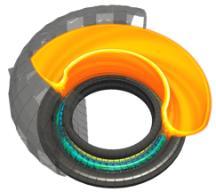LOCUST simulations of fast particle distributions
Contact people: Roddy Vann, Simon Pinches (ITER), Rob Akers (CCFE) & Sam Ward

Particles from neutral beam injection (NBI) heating systems are initially monoenergetic (i.e. a fixed energy determined by the NBI power supply. When they collide with the plasma, these particles become charged, scatter off other plasma particles and lose energy. The details of this process determines the efficiency of the heating scheme and the stability of the plasma with respect to potentially detrimental plasma waves (see next section). With funding from ITER and in collaboration with CCFE, we are using the Lorentz Orbit Code for Use in Stellarators and Tokamaks (LOCUST), optimised for execution on graphical processing units (GPUs), to predict the fast particle distribution on ITER, and validate these predictions by comparison with experimental observations from existing experiments. We have a particular interest investigating whether the fast particle distribution on ITER will be significantly modified by the application of the non-axisymmetric ELM-control fields.
